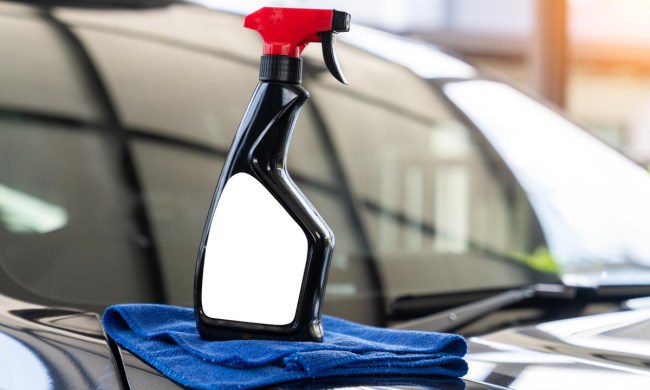
Whether you’re putting on a full-fledged concert or hosting a backyard party, it’s easy to buy and operate a handheld microphone thanks to these budget-friendly options. We reviewed some of the best budget microphones of 2024 that are all under $150.
Our top pick from GearIT is available for around $20 and features all the bells and whistles you need for a high-quality sound experience. These options are capable of providing decent clarity for vocals while also capturing rich acoustic sounds, bringing all of your parties and performances to the next level.
The best budget microphones
GearIT budget microphone – Best overall

The GearIT Dynamic Cardioid stage microphone is great for both on-stage performances and at-home voice recording. Whether your passion is music or podcasting, this microphone’s build quality and precision meld together at an unbeatable price. It is easy to connect to computers, interfaces, or mixers, just make sure to buy an xlr mic cable because it’s not included.
With a simple built-in on/off switch, you can control the live sound, and prevent unintentional hot mic situations. Its metal grille and foam windscreen shield the diaphragm from unwanted plosives and wind noise. All of these features in a $20 microphone, make it the best overall budget microphone.
Key Features
- Dynamic vocal XLR microphone
- Built-in on/off switch
- Rugged design with steel construction
- Metal grille for protection
- Foam windscreen included
- Comes with a mic clip
- Includes a zipper storage bag
Pros
- Microphone clip included
- Steel construction
- Built in on/off switch
Cons
- No hard case
Shure budget microphone – Best pop filter

The Shure SM58-LC cardioid dynamic vocal stage microphone is a sophisticated piece of audio equipment with great studio performance. Its pneumatic shock mount, spherical mesh grille with a built-in pop filter, and 3-pin XLR connector deliver crisp and clear audio quality, capturing the rich tones of your voice.
The built-in pop filter eliminates plosive sounds, so vocals don’t have harsh interruptions. Plus, the A25D mic clip and the storage bag make it convenient for transport and storage. If you’re in the market for a reliable, high-quality vocal stage microphone that excels in both studio work and podcasting, the Shure SM58-LC is a commendable choice.
Key Features
- Tailored frequency for vocal clarity
- Brightened midrange for precise vocals
- Uniform cardioid polar pattern
- Spherical mesh grille and pop filter
- Durable and break-resistant construction
- Capable of onstage and studio usage
- Includes swivel stand adapter and storage bag
Pros
- Excellent for live and studio work
- Reduces background noise
- Built with durable quality
Cons
- Requires additional preamp
Pyle budget microphone – Ultra-wide frequency

The Pyle handheld microphone boasts an ultra-wide frequency response, ensuring a warm, bassy sound that resonates with clarity and depth. The high signal output specifically amplifies vocals and singing, making it an ideal choice for musicians and performers.
This vocal stage microphone goes beyond delivering great sound. It endures too, thanks to its rugged construction and steel mesh grill, which allows it to withstand live performances. The built-in acoustic pop filter and integrated low-noise circuitry work in harmony to filter out unwanted noise, ensuring the focus remains on your vocals. The 15ft XLR to 1/4” audio connection cable makes it convenient for stage performances.
Key Features
- Cardioid pickup pattern for clear source capture
- Built-in acoustic pop filter
- Ultra-wide frequency response system
- 15 ft XLR-to-1/4 cable included
- All-metal construction with zinc die-cast case
- Steel mesh windscreen with anti-dent ring
- Requires mono/stereo adapter for stereo ports
Pros
- Delivers clear, high-quality sound
- Durable and sturdy build
- Comes with a decent quality cable
Cons
- Sizzles on high-end
SE Electronics budget microphone – Best vocal sound

The SE Electronics V7 studio grade microphone has a robust all-metal design, including a zinc alloy chassis and a spring steel mesh grille, which withstands the rigors of on-stage stress for prolonged periods. The gold-plated XLR connector offers a steady, loss-free signal connection that lasts for years.
The DMC7 dynamic element imparts a natural, crisp sound to capture vocals. Its super-cardioid capsule design helps filter your voice from other instruments, providing vast gain before feedback. Its patented integrated shock mount skillfully decouples the capsule from mechanical vibrations, thereby significantly reducing handling noise. This allows the freedom to move around the stage without fear of any unwanted noises infiltrating your performance.
Key Features
- All-metal housing with zinc alloy chassis
- Beveled spring steel grille for reliability
- Gold-plated XLR connector
- Internal windscreen in sE Red color
- Custom-developed DMC7 dynamic element
- Patented integrated shock mount
- Sensitivity level of 2.0mV/Pa
Pros
- Excellent noise reduction capability
- Provides clear, punchy mids
- High-end frequency response
Cons
- Not as sturdy as other models
Sennheiser budget microphone – Most professional

The Sennheiser Professional E 935 dynamic cardioid microphone, both wired and wireless, delivers exceptional clarity and crispness that cuts through the mix, whether on stage or in the studio. It’s built to withstand pressure, energizing your performances with its high output making it ideal for the working musician. This microphone guarantees excellent sound results all year round, 365 days, a constant companion for your vocal journey.
What sets this vocal stage microphone apart is its compatibility with high-impedance interfaces. It champions in providing a sound that is consistently clear and powerful, making it a first choice for rental companies.
Key Features
- Cardioid vocal stage microphone
- Designed for high output performances
- 365-day excellent sound performance
- Ideal for rental companies
- Shock-resistant capsule design
- Includes hum compensating coil
- Built with neodymium ferrous magnet and boron
- Encased in 100% metal for toughness
Pros
- High clarity and crispness of sound
- Captures voice very well
- Durable and long-lasting
Cons
- Can cause system feedback

How to pick the perfect budget microphone
Type of microphone
It’s important to distinguish different types of microphones before buying. There are primarily two types: dynamic and condenser microphones. Dynamic mics excel in durability and handle high sound pressure levels, perfect for on-stage performances. On the other hand, condenser mics offer superior sound quality and sensitivity, ideal for studio recording. Analyze your primary requirements to select the right type.
Polar pattern
The polar pattern of a microphone refers to its sensitivity to sound coming from different directions. The most common polar patterns are cardioid, supercardioid, and omnidirectional. Cardioid mics focus on sounds directly in front, effectively reducing background noise. Supercardioid mics have a narrower focus but capture some sound from the rear. Omnidirectional mics pick up sound from all directions. Choose a pattern that suits your stage setup and performance style.
Frequency response
The frequency response of a microphone plays a crucial role in how it picks up sound. It refers to the range of frequencies a microphone can capture and reproduce. For vocals, a microphone with a frequency response between 80 Hz to 15 kHz usually works well. A wider frequency response might be beneficial if you want to capture more details or if you have a particularly high or low voice.
Build quality
The build quality of a microphone directly affects its longevity and reliability. As a stage performer, your microphone might be subject to drops, travels, and varying environmental conditions. Therefore, ensure that your microphone has a robust construction with high-quality materials. It’s a wise investment to buy a microphone that withstands the test of time and performance demands.
Connectivity
In today’s digital age, connectivity is an essential attribute you should not overlook. Most stage microphones come with XLR connectors for their superior sound quality. However, USB microphones are also gaining popularity due to their plug-and-play convenience. Additionally, wireless microphones offer you the freedom of movement on stage. Consider your stage requirements, sound system setup, and personal preferences while choosing the connectivity.
Price
Finally, the price of the vocal stage microphone is a significant factor to consider. The cost of vocal stage microphones can vary widely based on their features, brand, and quality. However, keep in mind that a higher price does not always guarantee better performance. Evaluate your budget, but make sure not to compromise on the essential features you require. Remember, the best vocal stage microphone for you is one that meets your needs within your budget.
Conclusion
To wrap up, finding the best vocal stage microphone is a journey that requires a balance of technical knowledge and personal preferences. By considering the type, polar pattern, frequency response, build quality, connectivity, and price, you can be confident in your choice. Now, it’s time to let your voice shine through the right microphone!
People also ask
What are the different types of microphones?
There are mainly two types of vocal stage microphones – dynamic and condenser. Dynamic microphones are more durable and resistant to moisture, making them ideal for live performances. Condenser microphones, on the other hand, are more sensitive and provide a wider frequency response, but they require a power source and are more prone to damage.
How do I use a microphone?
To use a stage microphone, connect it to a sound system or recording device using the appropriate cable. Position the microphone at a suitable distance from your mouth – usually a few inches away. Make sure to hold the microphone at the correct angle to maximize sound quality.
How do I maintain a microphone?
Keeping your microphone in good condition involves regular cleaning and proper storage. Avoid dropping the microphone or exposing it to extreme temperatures. After each use, clean the microphone grill with a soft brush to remove any saliva or dust particles. When not in use, store the microphone in a dry and clean place, preferably in a protective case.
What should I do if my microphone is not working?
If your microphone is not working, first check the connection to the sound system or recording device. Ensure that the microphone is on and the volume is at an appropriate level. If the problem persists, the microphone may need professional servicing.
How can I reduce feedback when using a microphone?
To reduce feedback, avoid pointing the microphone directly at speakers or monitors. Use a microphone stand to maintain a consistent distance and angle. Utilize sound checks to adjust the settings of the sound system for optimal performance.
How does proximity affect the sound from a microphone?
Proximity effect refers to the increase in bass or low-frequency response when the source of sound is close to the microphone. For a vocal stage microphone, this means that the closer the singer’s mouth is to the microphone, the more bass the voice will have.
Can I use a wireless microphone?
Yes, wireless vocal stage microphones are available and provide the added advantage of free movement on stage without worrying about tripping over cables. However, they can be susceptible to interference, and their sound quality and range may not be as good as wired microphones.


